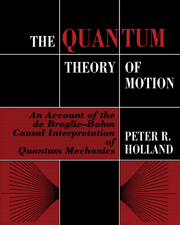 The Quantum Theory of Motion
The Quantum Theory of Motion Book contents
- Frontmatter
- Contents
- Preface
- 1 Quantum mechanics and its interpretation
- 2 Hamilton–Jacobi theory
- 3 Elements of the quantum theory of motion
- 4 Simple applications
- 5 Interference and tunnelling
- 6 The classical limit
- 7 Many-body systems
- 8 Theory of experiments
- 9 Spin ½: the Pauli theory
- 10 Spin ½: the rigid rotator
- 11 The Einstein–Podolsky–Rosen experiment and nonlocality
- 12 Relativistic quantum theory
- References
- Index
10 - Spin ½: the rigid rotator
Published online by Cambridge University Press: 20 January 2010
- Frontmatter
- Contents
- Preface
- 1 Quantum mechanics and its interpretation
- 2 Hamilton–Jacobi theory
- 3 Elements of the quantum theory of motion
- 4 Simple applications
- 5 Interference and tunnelling
- 6 The classical limit
- 7 Many-body systems
- 8 Theory of experiments
- 9 Spin ½: the Pauli theory
- 10 Spin ½: the rigid rotator
- 11 The Einstein–Podolsky–Rosen experiment and nonlocality
- 12 Relativistic quantum theory
- References
- Index
Summary
Classical dynamics of rigid bodies
The difficulties in formulating the theory of spin ½ systems outlined at the end of the last chapter may be avoided if we start from a classical theory of rotation in which the translational and orientational coordinates enter on a symmetrical footing, and pass to the quantum theory via the standard canonical quantization procedure. The result is not simply the Pauli theory written in a different matrix representation but a more general physical theory which explicitly incorporates in the wave equation the extended character of the bodies considered, through moment-of-inertia-dependent terms. As expected, the spin ½ character of the wave is manifested through the dependence of the body motion on the total quantum state via quantum potential and torque terms. Spin is not usually approached from this angle in basic quantum mechanics texts so it is worthwhile to build up the theory from scratch (for a more rigorous treatment see Normand (1980) and for further details: Bopp & Haag (1950), Rosen (1951, 1984), van Winter (1954), Dankel (1970), Holland (1988a, b)).
We begin by reviewing some basic results in the classical canonical theory of rigid body motion. Our treatment is confined to a rigid homogeneous sphere with moment of inertia I about any axis passing through its centre, where the centre of mass is located. The sphere carries a rigid charge and a magnetic moment. By Chasle's theorem an arbitrary displacement of a rigid body is composed of a translation together with a rotation about a line fixed in the body.
Information
- Type
- Chapter
- Information
- The Quantum Theory of MotionAn Account of the de Broglie-Bohm Causal Interpretation of Quantum Mechanics, pp. 424 - 457Publisher: Cambridge University PressPrint publication year: 1993